In Walt Disney's musical-fantasy Mary Poppins (Robert Stevenson, 1964) live-action is successfully combined with animation. The songs by the Sherman Brothers are performed by a great cast with Julie Andrews in her film debut, Dick Van Dyke, David Tomlinson, and Glynis Johns. The film is based on the first book in P. L. Travers's series about magical nanny Mary Poppins, who employs music and adventure to help two neglected children become closer to their father. Mary Poppins received a total of 13 Academy Award nominations, including Best Picture – a record for any other film released by Walt Disney Studios – and won five, including the Best Actress Oscar for Julie Andrews. A sequel titled Mary Poppins Returns (Rob Marshall, 2018) with Emily Blunt as Mary is scheduled to be released next month, on 19 December 2018.
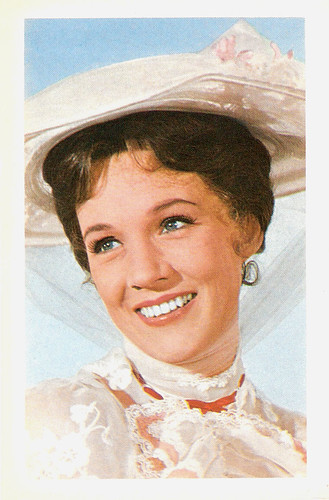
Vintage postcard. Photo: still from Mary Poppins (1964).
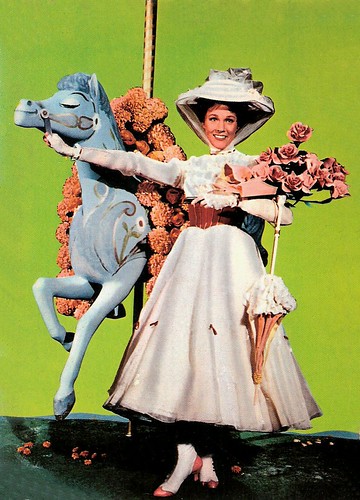
Spanish postcard by EdicionesTarje Fher / Ediciones Mandolina, 1964. Photo: Walt Disney Productions. Still from Mary Poppins (1964).
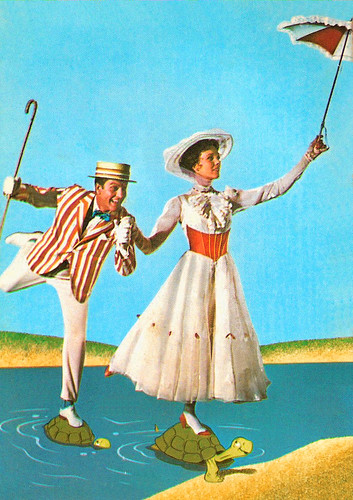
Spanish postcard by Ediciones Tarje Fher / Ediciones Mandolina, 1964. Photo: Walt Disney Productions. Still from Mary Poppins (1964).
In Edwardian London, 1910, Bert (played by Dick van Dyke), a Cockney chimneysweep, entertains a crowd as a one-man band when he senses a change in the wind. Afterwards, he directly addresses the audience, and gives them a tour of Cherry Tree Lane, stopping outside the Banks family’s home. George Banks (David Tomlinson) returns home to learn from his wife, Winifred (Glynis Johns), that Katie Nanna (Elsa Lanchester) has left their service after Jane (Karen Dotrice) and Michael (Matthew Garber) ran away again.
Jane and Michael are returned shortly after by Constable Jones (Arthur Treacher), who reveals the children were chasing a lost kite. The children ask their father to help build a better kite, but he dismisses them. Taking it upon himself to hire a new nanny, the uptight Mr. Banks advertises for a stern, no-nonsense nanny. Instead, Jane and Michael present their own advertisement for a kinder, sweeter nanny. Mr. Banks rips up the letter, and throws the scraps in the fireplace, but the remains of the advertisement magically float up, and out into the air.
The next day, a number of elderly, sour-faced nannies wait outside the Banks' home, but a strong gust of wind blows them away, and Jane and Michael witness a young nanny descending from the sky using her umbrella. Presenting herself to Mr. Banks, Mary Poppins (Julie Andrews) calmly produces the children's restored advertisement, and agrees with its requests, but promises the astonished banker she will be firm with his children. As Mr. Banks puzzles over the advertisement's return, Mary Poppins hires herself, and convinces him it was originally his idea. She meets the children, then helps them tidy their nursery through song, before heading out for a walk in the park.
Outside, they meet Bert, working as a sidewalk artist. Mary Poppins uses her magic to hop the group into one of Bert's chalk drawings. While the children ride on a carousel, Mary Poppins and Bert go on a leisurely stroll. Mary Poppins later enchants the carousel horses, and participates in a horse race, which she wins. While being asked to describe her victory, Mary Poppins announces the nonsense word "Supercalifragilisticexpialidocious".
Embarking on a series of fantastical adventures with Mary and Bert, the children try to pass on some of their nanny's sunny attitude to their preoccupied parents. At the end of the film, the wind changes, meaning Mary Poppins must leave. With her work done, Mary Poppins flies away, with Bert bidding her farewell, telling her not to stay away too long.

French postcard by Les Presses de Belleville, Paris, no. 101. Photo: Walt Disney Productions. Publicity still for Mary Poppins (Robert Stevenson, 1964).
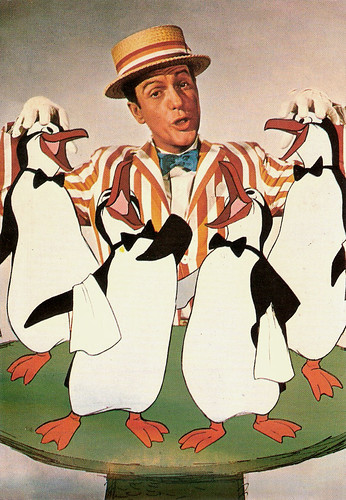
French postcard by Les Presses de Belleville, Paris, no. 103. Photo: Walt Disney Productions. Publicity still for Mary Poppins (Robert Stevenson, 1964).

French postcard by Les Presses de Belleville, Paris, no. 107. Photo: Walt Disney Productions. Publicity still for Mary Poppins (Robert Stevenson, 1964).
Julie Andrews got the prime role of Mary Poppins soon after she was passed over by Jack L. Warner and replaced with Audrey Hepburn for the role of Eliza Doolittle in his screen adaptation of My Fair Lady, even though Andrews had originated the role on Broadway. When Disney first approached Andrews about taking on the role, Andrews was three months pregnant and therefore was not sure she should take it. Disney assured her that the crew would be fine with waiting to begin filming until after she had given birth so that she could play the part.
Julie Andrews also provided the voice in two other sections of the film: during A Spoonful of Sugar, she provided the whistling harmony for the robin, and she was also among the chorus performing as the animated Pearly Band during Supercalifragilisticexpialidocious.
David Tomlinson, besides playing Mr. Banks, provided the voice of Mary's talking umbrella and numerous other voice-over parts (including that of Admiral Boom's first mate). During the Jolly Holiday sequence, the three singing Cockney geese were all voiced by Marni Nixon, a regular aural substitute for actresses with substandard singing voices. Nixon would later provide the singing voice for Hepburn in My Fair Lady and play one of Andrews' fellow nuns in The Sound of Music.
Andrews later beat Hepburn for the Best Actress Award at the Golden Globes for their respective roles. Andrews would also win the Academy Award for Best Actress for her role. Hepburn did not receive a nomination. Richard Sherman, one of the songwriters, also voiced a penguin as well as one of the Pearlies. Robert Sherman dubbed the speaking voice for Jane Darwell who played the 'Bird Woman', an old woman who sells breadcrumbs for the pigeons on the steps of St Paul's Cathedral. It was to be her last screen appearance. Darwell's voice was too weak to be heard in the soundtrack and Sherman's voice is heard saying her only line: "Feed the Birds, Tuppence a bag."
Disney cast Dick Van Dyke in the key supporting role of Bert after seeing his work on The Dick Van Dyke Show. After winning the role of Bert, Van Dyke lobbied to also play the senior Mr. Dawes, but Disney originally felt he was too young for the part. Van Dyke eventually won Disney over after a screen test. In the end credits cast list, the actor playing Mr. Dawes, Sr. is initially shown as NAVCKID KEYD, then the letters unscramble themselves to show that this is a second role played by Dick Van Dyke. Although he is fondly remembered for this film, Van Dyke's attempt at a Cockney accent is regarded as one of the worst film accents in history.
The film was a major hit, worldwide, and quickly achieved the legendary status it holds today. Ben Burgraff at IMDb: "Mary Poppins is one of that select group of films that can truly be called 'Classic', a project conceived in love and filled with so much child-like wonder that it will never grow old or 'out-of-date'. Certainly the crowning achievement of Walt Disney's remarkable career, both story-wise and technically, the film remains an unsurpassed achievement!"
Dan Jardine at AllMovie: "The story's attack on the materialistic values and staid lives of turn-of-the-century England is undercut by the Disney-like romanticizing of the lives of the working class, particularly the chimney sweeps. The children give predictably too-cute performances, but the direction by Robert Stevenson keeps things moving briskly enough that we don't get stuck in sticky sweetness. The entire set was constructed indoors and it shows: the 'outdoor' scenes are bathed in a dull gray light. Still, there are a number of unforgettable song-and-dance sequences that stand the test of time, and the tale's overall subversiveness is distinctly appealing."

French postcard by Les Presses de Belleville, Paris, no. 104. Photo: Walt Disney Productions. Publicity still for Mary Poppins (Robert Stevenson, 1964).
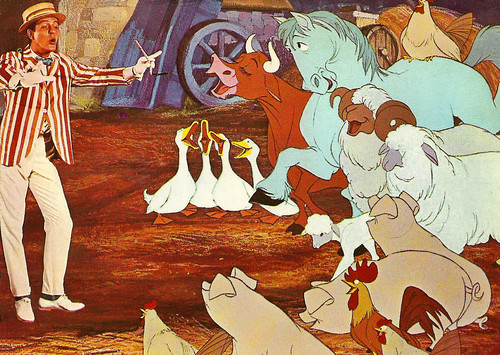
French postcard by Les Presses de Belleville, Paris, no. 108. Photo: Walt Disney Productions. Publicity still for Mary Poppins (Robert Stevenson, 1964).
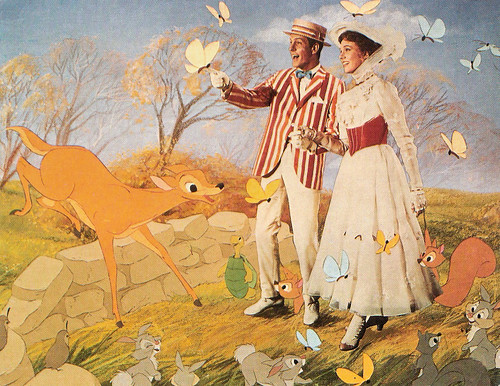
French postcard. Photo: Walt Disney Productions. Publicity still for Mary Poppins (Robert Stevenson, 1964).
Sources: Ben Burgraff (IMDb), Dan Jardine (AllMovie), Hal Erickson (AllMovie), Wikipedia and IMDb.

Vintage postcard. Photo: still from Mary Poppins (1964).

Spanish postcard by EdicionesTarje Fher / Ediciones Mandolina, 1964. Photo: Walt Disney Productions. Still from Mary Poppins (1964).

Spanish postcard by Ediciones Tarje Fher / Ediciones Mandolina, 1964. Photo: Walt Disney Productions. Still from Mary Poppins (1964).
Supercalifragilisticexpialidocious
In Edwardian London, 1910, Bert (played by Dick van Dyke), a Cockney chimneysweep, entertains a crowd as a one-man band when he senses a change in the wind. Afterwards, he directly addresses the audience, and gives them a tour of Cherry Tree Lane, stopping outside the Banks family’s home. George Banks (David Tomlinson) returns home to learn from his wife, Winifred (Glynis Johns), that Katie Nanna (Elsa Lanchester) has left their service after Jane (Karen Dotrice) and Michael (Matthew Garber) ran away again.
Jane and Michael are returned shortly after by Constable Jones (Arthur Treacher), who reveals the children were chasing a lost kite. The children ask their father to help build a better kite, but he dismisses them. Taking it upon himself to hire a new nanny, the uptight Mr. Banks advertises for a stern, no-nonsense nanny. Instead, Jane and Michael present their own advertisement for a kinder, sweeter nanny. Mr. Banks rips up the letter, and throws the scraps in the fireplace, but the remains of the advertisement magically float up, and out into the air.
The next day, a number of elderly, sour-faced nannies wait outside the Banks' home, but a strong gust of wind blows them away, and Jane and Michael witness a young nanny descending from the sky using her umbrella. Presenting herself to Mr. Banks, Mary Poppins (Julie Andrews) calmly produces the children's restored advertisement, and agrees with its requests, but promises the astonished banker she will be firm with his children. As Mr. Banks puzzles over the advertisement's return, Mary Poppins hires herself, and convinces him it was originally his idea. She meets the children, then helps them tidy their nursery through song, before heading out for a walk in the park.
Outside, they meet Bert, working as a sidewalk artist. Mary Poppins uses her magic to hop the group into one of Bert's chalk drawings. While the children ride on a carousel, Mary Poppins and Bert go on a leisurely stroll. Mary Poppins later enchants the carousel horses, and participates in a horse race, which she wins. While being asked to describe her victory, Mary Poppins announces the nonsense word "Supercalifragilisticexpialidocious".
Embarking on a series of fantastical adventures with Mary and Bert, the children try to pass on some of their nanny's sunny attitude to their preoccupied parents. At the end of the film, the wind changes, meaning Mary Poppins must leave. With her work done, Mary Poppins flies away, with Bert bidding her farewell, telling her not to stay away too long.

French postcard by Les Presses de Belleville, Paris, no. 101. Photo: Walt Disney Productions. Publicity still for Mary Poppins (Robert Stevenson, 1964).

French postcard by Les Presses de Belleville, Paris, no. 103. Photo: Walt Disney Productions. Publicity still for Mary Poppins (Robert Stevenson, 1964).

French postcard by Les Presses de Belleville, Paris, no. 107. Photo: Walt Disney Productions. Publicity still for Mary Poppins (Robert Stevenson, 1964).
Giving his voice to Mary's talking umbrella
Julie Andrews got the prime role of Mary Poppins soon after she was passed over by Jack L. Warner and replaced with Audrey Hepburn for the role of Eliza Doolittle in his screen adaptation of My Fair Lady, even though Andrews had originated the role on Broadway. When Disney first approached Andrews about taking on the role, Andrews was three months pregnant and therefore was not sure she should take it. Disney assured her that the crew would be fine with waiting to begin filming until after she had given birth so that she could play the part.
Julie Andrews also provided the voice in two other sections of the film: during A Spoonful of Sugar, she provided the whistling harmony for the robin, and she was also among the chorus performing as the animated Pearly Band during Supercalifragilisticexpialidocious.
David Tomlinson, besides playing Mr. Banks, provided the voice of Mary's talking umbrella and numerous other voice-over parts (including that of Admiral Boom's first mate). During the Jolly Holiday sequence, the three singing Cockney geese were all voiced by Marni Nixon, a regular aural substitute for actresses with substandard singing voices. Nixon would later provide the singing voice for Hepburn in My Fair Lady and play one of Andrews' fellow nuns in The Sound of Music.
Andrews later beat Hepburn for the Best Actress Award at the Golden Globes for their respective roles. Andrews would also win the Academy Award for Best Actress for her role. Hepburn did not receive a nomination. Richard Sherman, one of the songwriters, also voiced a penguin as well as one of the Pearlies. Robert Sherman dubbed the speaking voice for Jane Darwell who played the 'Bird Woman', an old woman who sells breadcrumbs for the pigeons on the steps of St Paul's Cathedral. It was to be her last screen appearance. Darwell's voice was too weak to be heard in the soundtrack and Sherman's voice is heard saying her only line: "Feed the Birds, Tuppence a bag."
Disney cast Dick Van Dyke in the key supporting role of Bert after seeing his work on The Dick Van Dyke Show. After winning the role of Bert, Van Dyke lobbied to also play the senior Mr. Dawes, but Disney originally felt he was too young for the part. Van Dyke eventually won Disney over after a screen test. In the end credits cast list, the actor playing Mr. Dawes, Sr. is initially shown as NAVCKID KEYD, then the letters unscramble themselves to show that this is a second role played by Dick Van Dyke. Although he is fondly remembered for this film, Van Dyke's attempt at a Cockney accent is regarded as one of the worst film accents in history.
The film was a major hit, worldwide, and quickly achieved the legendary status it holds today. Ben Burgraff at IMDb: "Mary Poppins is one of that select group of films that can truly be called 'Classic', a project conceived in love and filled with so much child-like wonder that it will never grow old or 'out-of-date'. Certainly the crowning achievement of Walt Disney's remarkable career, both story-wise and technically, the film remains an unsurpassed achievement!"
Dan Jardine at AllMovie: "The story's attack on the materialistic values and staid lives of turn-of-the-century England is undercut by the Disney-like romanticizing of the lives of the working class, particularly the chimney sweeps. The children give predictably too-cute performances, but the direction by Robert Stevenson keeps things moving briskly enough that we don't get stuck in sticky sweetness. The entire set was constructed indoors and it shows: the 'outdoor' scenes are bathed in a dull gray light. Still, there are a number of unforgettable song-and-dance sequences that stand the test of time, and the tale's overall subversiveness is distinctly appealing."

French postcard by Les Presses de Belleville, Paris, no. 104. Photo: Walt Disney Productions. Publicity still for Mary Poppins (Robert Stevenson, 1964).

French postcard by Les Presses de Belleville, Paris, no. 108. Photo: Walt Disney Productions. Publicity still for Mary Poppins (Robert Stevenson, 1964).

French postcard. Photo: Walt Disney Productions. Publicity still for Mary Poppins (Robert Stevenson, 1964).
Sources: Ben Burgraff (IMDb), Dan Jardine (AllMovie), Hal Erickson (AllMovie), Wikipedia and IMDb.
No comments:
Post a Comment